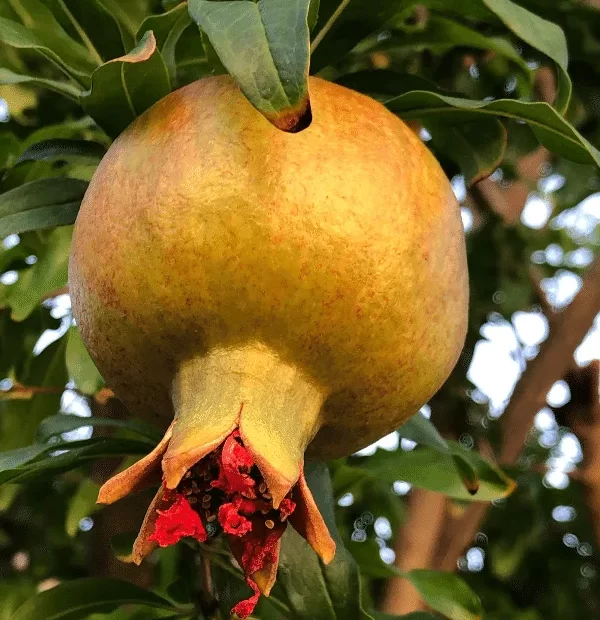The Ultimate Step-by-Step Guide to Growing Pomegranates
Pomegranates are a delicious and nutritious fruit that is enjoyed by people all over the world. They are also relatively easy to grow, making them a great option for home gardeners.
This guide will walk you through the process of growing pomegranates, from planting the seeds to harvesting the fruit. We’ll cover everything you need to know, including:

- The best time to plant pomegranates
- Where to plant pomegranates
- How to care for pomegranate trees
- How to pollinate pomegranates
- How to harvest pomegranates
By the end of this guide, you’ll be well on your way to growing your own delicious pomegranates. So what are you waiting for? Get started today!
The Ultimate Step-by-Step Guide to Growing Pomegranates
Step 1: Choose the Right Location
Pomegranates are a warm-weather fruit, so they need to be planted in an area that gets plenty of sunlight. They also need well-drained soil, so avoid planting them in areas that are prone to flooding.
Step 2: Prepare the Soil
Before planting your pomegranate tree, you’ll need to prepare the soil. Dig a hole that is twice as wide and deep as the root ball of your tree. Mix some compost or manure into the soil to improve drainage and fertility.
Step 3: Plant the Tree
Once you’ve prepared the soil, you can plant your pomegranate tree. Gently remove the tree from its pot and place it in the hole. Backfill the hole with soil, and water the tree thoroughly.
Step 4: Water and Fertilize the Tree
Pomegranate trees need regular watering, especially during the hot summer months. Water your tree deeply once a week, or more often if the weather is dry. You can also fertilize your tree once a month with a balanced fertilizer.
Step 5: Prune the Tree
Pomegranate trees can be pruned to maintain a desired shape and size. You can also prune the tree to remove dead or diseased branches. Pruning should be done in late winter or early spring.
Step 6: Harvest the Fruit
Pomegranates are ripe when the skin is a deep red color and the fruit is soft to the touch. To harvest the fruit, cut the pomegranate open and remove the seeds. The seeds can be eaten fresh, or they can be used to make juice, jam, or other preserves.
1. Choosing the Right Variety
There are many different varieties of pomegranates, each with its own unique flavor and appearance. When choosing a variety to grow, it is important to consider the climate in your area, as well as your personal preferences.
- Climate: Pomegranates are native to warm, dry climates, and they do best in USDA hardiness zones 8-11. However, there are some varieties that can tolerate colder climates, such as ‘Wonderful’ and ‘Early Wonderful’.
- Flavor: Pomegranate varieties vary in flavor from sweet to tart. Some popular varieties include ’Wonderful’, ‘Early Wonderful’, ‘Grenada’, and ’Sweet Pomegranate’.
- Appearance: Pomegranate varieties also vary in appearance. Some have large, juicy fruits, while others have smaller, more tart fruits. Some popular varieties include ‘Wonderful’, ‘Early Wonderful’, ’Grenada’, and ‘Sweet Pomegranate’.
Once you have considered the climate in your area and your personal preferences, you can choose the best variety of pomegranate to grow.
Here are a few tips for choosing a pomegranate variety:
- Start with a reputable nursery or garden center. They will be able to help you choose a variety that is suitable for your climate and growing conditions.
- Read the plant tags carefully. The tags will provide information on the variety’s hardiness zone, mature size, and fruit size and flavor.
- Ask the nursery staff for advice. They can help you narrow down your choices and find the best variety for your needs.
By following these tips, you can choose the best variety of pomegranate to grow in your garden.
2. Preparing the Soil
Pomegranates grow best in well-drained soil that is rich in organic matter. The ideal pH range for pomegranates is between 6.0 and 6.8. If your soil is too acidic, you can add lime to raise the pH. If your soil is too alkaline, you can add sulfur to lower the pH.
To prepare the soil for planting pomegranates, you will need to dig a hole that is twice as wide and deep as the root ball of the pomegranate seedling. Fill the hole with a mixture of potting soil, compost, and sand. Make sure the soil is well-drained by adding gravel or crushed rock to the bottom of the hole.
Once the soil is prepared, you can plant the pomegranate seedling. Water the seedling thoroughly and mulch the area around the plant to help retain moisture.
Pomegranate Soil Requirements
| Requirement | Description |
|---|---|
| pH | 6.0-6.8 |
| Drainage | Well-drained |
| Organic matter | Rich in organic matter |
| Moisture | Needs regular watering |
How to Prepare the Soil for Pomegranates
- Dig a hole that is twice as wide and deep as the root ball of the pomegranate seedling.
- Fill the hole with a mixture of potting soil, compost, and sand.
- Make sure the soil is well-drained by adding gravel or crushed rock to the bottom of the hole.
- Water the seedling thoroughly and mulch the area around the plant to help retain moisture.
3. Planting Your Pomegranate Tree
Pomegranates are relatively easy to grow, but there are a few things you need to know in order to get the best results.
- Choose a sunny spot with well-drained soil.
- Plant your pomegranate tree in the spring or early summer, after the last frost.
- Water your pomegranate tree regularly, especially during dry spells.
- Fertilize your pomegranate tree with a balanced fertilizer once a month during the growing season.
- Prune your pomegranate tree to keep it healthy and productive.
With proper care, your pomegranate tree will produce delicious fruit for many years to come.
4. Caring for Your Pomegranate Tree
Once your pomegranate tree has been planted, it’s important to care for it properly in order to ensure that it produces a bountiful harvest. Here are a few tips on how to care for your pomegranate tree:
- Water regularly. Pomegranate trees need plenty of water, especially during the hot summer months. Make sure to water your tree deeply once or twice a week, and more often if the weather is particularly dry.
- Fertilize regularly. Pomegranate trees benefit from a regular fertilization schedule. Apply a balanced fertilizer to your tree once a month during the growing season, and then once every two months during the winter.
- Prune your tree. Pruning your pomegranate tree is important for shaping it and encouraging new growth. Prune your tree in late winter or early spring, before the new growth begins.
- Protect your tree from pests and diseases. Pomegranate trees can be susceptible to a variety of pests and diseases, such as aphids, mites, and fungal diseases. Keep an eye on your tree for signs of pests or diseases, and treat them as soon as possible.
By following these tips, you can help your pomegranate tree to thrive and produce a delicious harvest of pomegranates.
Table of Contents
-
- Water regularly
- Fertilize regularly
- Prune your tree
- Protect your tree from pests and diseases
5. Harvesting Your Pomegranate Crop
Once your pomegranates have reached their full size and color, they are ready to be harvested.
You can also tell if a pomegranate is ripe by gently squeezing it. If the pomegranate feels slightly soft, it is ready to be harvested.The best time to harvest pomegranates is when the skin has turned a deep red color and the fruit is firm to the touch..
To harvest pomegranates, simply cut the stem off of the fruit and then gently pull the pomegranate apart. The pomegranate should come apart easily into individual segments. You can then remove the seeds from the segments and enjoy them fresh or use them in recipes.
Here are a few tips for harvesting pomegranates:
- Harvest pomegranates when the weather is dry. If the pomegranates are harvested when the weather is wet, the seeds will be more likely to mold.
- Harvest pomegranates in the morning. The pomegranates will be juicier and sweeter if they are harvested in the morning.
- Store pomegranates in a cool, dry place. Pomegranates can be stored for up to two weeks at room temperature or for up to six months in the refrigerator.
Pomegranate Recipes
Here are a few recipes that you can use with pomegranates:
- Pomegranate Salad: Toss together pomegranate seeds, chopped red onion, chopped cucumber, chopped parsley, and crumbled feta cheese. Drizzle with olive oil and lemon juice and season with salt and pepper.
- Pomegranate Smoothie: Blend together pomegranate juice, yogurt, honey, and ice.
- Pomegranate Chicken: Marinate chicken breasts in pomegranate juice, olive oil, and garlic. Grill the chicken until cooked through. Serve with pomegranate seeds and a side of rice.
Resources
1. The University of California Master Gardeners: This resource from the University of California Master Gardeners provides a comprehensive guide to growing pomegranates, including information on choosing the right variety, planting and caring for your trees, and harvesting and storing your pomegranates.
- The Pomegranate Institute: The Pomegranate Institute is a non-profit organization dedicated to promoting the cultivation and consumption of pomegranates. This resource provides information on the history of pomegranates, their nutritional benefits, and how to grow and care for your own pomegranate trees.
To Wrap It Up
Growing pomegranates is a rewarding experience, and with this step-by-step guide, you’ll be able to enjoy fresh, delicious pomegranates in no time. So what are you waiting for? Start growing your own pomegranates today!
- Cat Palm vs Majesty Palm: Which Should You Choose? - June 30, 2024
- Flowers That Survive Winter: Discover the Exceptional No. 5 - June 30, 2024
- The Ultimate Guide to the Growth and Care of the Black Pagoda Lipstick Plant - June 29, 2024





